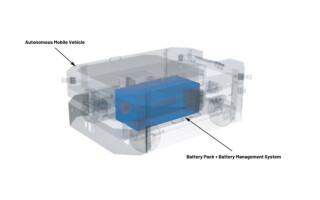Analog Devices
PO Box 9106
Norwood, MA 02062 [email protected]
(781) 329-4700
https://www.analog.com/en/index.html

Unlocking Efficiency: How ADI Battery Management Solutions Empower Safer, Smarter Mobile Robots - Blog
August 27, 2024In the rapidly evolving landscape of automated warehouses and manufacturing facilities, meticulous control over each component of the process is paramount. Even the slightest downtime can result in significant repercussions. Autonomous mobile robots and automated guided vehicles play a vital role in this ecosystem, requiring the implementation of precise monitoring and fail-safe systems.
Revolutionizing Safety: Unveiling the Power of Safety Bubble Detectors in Robotics - Blog
August 07, 2024This article will explain the architecture of real-time safety bubble detection that includes challenges for developing a modular solution, optimizing such a high data bandwidth application to run at 30 frames per second (FPS), and designing a multithread application and algorithm to accurately detect objects close to the ground.
Mouser New Product of the Week: Analog Devices’ MAX96724/F/R Evaluation Kits - Story
June 10, 2024High-speed data transfer, simplified wiring, and strong signal integrity are important features of high-speed serializers and deserializers (SerDes) devices.
Embedded Executive: What You Can Do With Medical Wearables, Analog Devices (ADI) - Podcast
May 08, 2024Medical wearables can greatly enhance the quality of life for many people. This can be done by instantly accessing medical information and potentially alerting a professional, or simply tracking stats on an individual.
According to Andrew Burt, the Director of Product Line Management of Digital Healthcare at Analog Devices, his company has produced a kit for developers who are coming up with ideas on how to pull in this data and then what to do with it. It’s pretty amazing what can be done, and it’s not nearly as hard as you might think. Check out this week’s Embedded Executives podcast.
Correction: The ADI wearable device referred to in the podcast has received FDA 510(k) clearance, not FDA approval.
Analog Devices to Demo its Industrial Network of the Future at embedded world 2024 - News
March 20, 2024embedded world 2024 will have Analog Devices showcasing how it is advancing embedded system solutions. Visitors to Hall 4A, Booth 360 will witness 16 feature-rich demos highlighting the company’s ability to deliver system level solutions across industrial markets.
Mouser New Product of the Week: Analog Devices Inc. ADL5308 Evaluation Board & Kit - Story
March 04, 2024There are a wide variety of sensing and conversion-based applications that can benefit from the use of a tool that’s designed to support engineers looking to process signals. Tools like this would allow them to make better-informed design decisions while also enabling the integration of these applications into larger systems.






